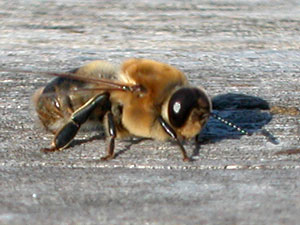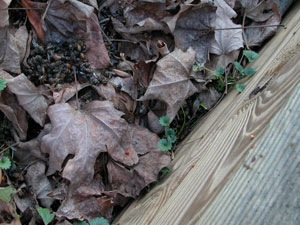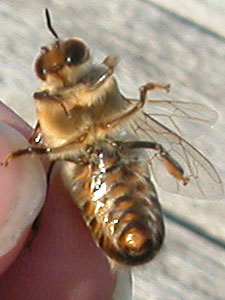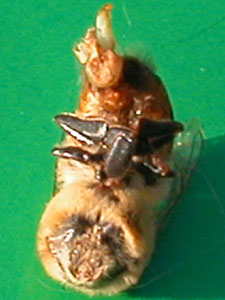 This is one very, very warm winter, apparently the warmest in over a century so far. The bees fly every day, so I fret over whether or not I can keep them fed until the flowers bloom (unless they bloom early, and risk death by frost when, or if, the winter arrives). I last fed the roof bees 6 days ago, so I trooped up there to see what they had eaten and refill the feeders.
This is one very, very warm winter, apparently the warmest in over a century so far. The bees fly every day, so I fret over whether or not I can keep them fed until the flowers bloom (unless they bloom early, and risk death by frost when, or if, the winter arrives). I last fed the roof bees 6 days ago, so I trooped up there to see what they had eaten and refill the feeders.All sorts of uncomfortable sites awaite, including the one in the picture above: a great big fat hairy drone. Don't get me wrong — I'm kind of fond of the lazy bugs — but he should have been dead by November. As near as I can tell, the only reason this dude has been kicked out of the hive is that he is missing an antenna. The girls have probably continued raising brood throughout this mild winter, further stressing a food supply that was light to start with. As it stands, Twain took almost a gallon of 2:1 sugar syrup in 6 days, which I replaced. Though Wilde still seems heavy, I gave those girls three quarts.
 The second, but more heartbreaking sight was the return of dead bees around the Twain hive. The picture here is of dead bees in front of the Mill hive out in the 'burbs, though. Why is it here? Because I think that the two hives have a lot in common, including difficult-to-manage varroa infestations and signs of Paralytic Mite Syndrome (PMS). The varroa have probably been knocked down by now, which means their larval habit of crippling baby bee wings is less obvious. But the virus they have already imparted to the bees may be shortening lives. Both hives share the unique characteristic of major K-wings earlier in the season. I think it's PMS.
The second, but more heartbreaking sight was the return of dead bees around the Twain hive. The picture here is of dead bees in front of the Mill hive out in the 'burbs, though. Why is it here? Because I think that the two hives have a lot in common, including difficult-to-manage varroa infestations and signs of Paralytic Mite Syndrome (PMS). The varroa have probably been knocked down by now, which means their larval habit of crippling baby bee wings is less obvious. But the virus they have already imparted to the bees may be shortening lives. Both hives share the unique characteristic of major K-wings earlier in the season. I think it's PMS.And there is a rub to that: I should probably stop reinforcing those hives, and try to reduce virus levels by shaking them out onto clean foundation in the Spring. The virus gets into the wood and the wax and the bees' bodies, and cannot truly be eradicated. By setting them up clean, I can reduce the levels and perhaps give them a chance to develop some resistance. More logical people might let the colonies pass on naturally.
 But back to the out-of-season drone. Here's what his underside looks like. Can you see how lovely and fuzzy he is, particularly around his front legs? I'm kind of wowed by the scalloped pattern of his exoskeleton under there, so pretty. Do you notice that the base of his abdomen has a little golden cone-shaped outcropping rather than a stinger? That's why I could be so free in photographing him: he can only buzz at me. But I have a kind of freaky curiousity to show you, too.
But back to the out-of-season drone. Here's what his underside looks like. Can you see how lovely and fuzzy he is, particularly around his front legs? I'm kind of wowed by the scalloped pattern of his exoskeleton under there, so pretty. Do you notice that the base of his abdomen has a little golden cone-shaped outcropping rather than a stinger? That's why I could be so free in photographing him: he can only buzz at me. But I have a kind of freaky curiousity to show you, too.  While working in one of her hives over a month ago, MaryEllen discovered this dead drone on the bottom board. As you can see, his wedding tackle is fully deployed, something neither she nor I had ever seen before. You can see why, when mating in flight, there is no way that retraction is an option, and the drone dies. And this drone is a little dried out by now (MaryEllen originally gave him to me to try to photograph under my microscope, but the object was actually so big that I could not get good depth of field. In the course of my manipulations, the poor guy's head came off, sorry). If you click this picture, you can get another view of the same thing (it seemed morbid to post more than one here).
While working in one of her hives over a month ago, MaryEllen discovered this dead drone on the bottom board. As you can see, his wedding tackle is fully deployed, something neither she nor I had ever seen before. You can see why, when mating in flight, there is no way that retraction is an option, and the drone dies. And this drone is a little dried out by now (MaryEllen originally gave him to me to try to photograph under my microscope, but the object was actually so big that I could not get good depth of field. In the course of my manipulations, the poor guy's head came off, sorry). If you click this picture, you can get another view of the same thing (it seemed morbid to post more than one here).I need to run away now and try to get some more food on the Monastery bees, if they need it. It will rain and rain (and be over 60 degrees each day) tomorrow and the day after. At least those girls don't seem to have so many dead sisters on their doorstep.
6 comments:
how are you! 1 am 35murderous intent youths who keep bees from korea. you blow it will bee wrong
and there is enjoying report.
it sees the image of the photography the beautiful woman it happens. korea the emergecy was caught to the warm brasier being caused by honeybee civil offical
if korean keeping bees is anxious,
caliber come. it is a secret intention cafe address.
http://cafe.daum.net/chungsonghoney
Ok, so the comment above seems a bit strange, but I think it is the result of an automatic translation. I went to the site, and it appears to be a member portal for a beekeeping club in Korea, "Green Mountain Honey."
When I ran THEIR site through an automatic translater (Google language tools) it looks like there is information I'd like to have!
So I am thinking that the 35 murderous youths might actually be 35 young people who are also illicit beekeepers. Rock on, my friends!
Just an update: it is rainy, so it is not much of a beekeeping day (1/12/07) but I just gave Wilde a quart of 2:1 sugar syrup. They had taken all that they received a week ago, but they are still nice and low inside the hive. This means that they still have good stores for the remainder of the winter. I banged on the side of the box to be sure that there were still bees in there, they were so low!
Twain was quite different. The bees were all up top, meaning that there is danger of starvation. Of the 6 quarts left a week ago, 3 were completely empty and three were half empty. They got two more filled (I ran out of sugar water) and I will return after the weekend to give them more.
Wilde and the two monastery hives are therefore in the best shape this winter. Colvin and Twain are sick and light.
Here's what I wonder: how did he end up on the bottom board? Did he manage to return to the hive after mating, only to die there? Or did he get confused and prepare to mate in the hive?
I'm sorry your girls are having a rough winter :(
We have 3 hives. This is our third year beekeeping north of Chicago. I am trying to see if there is anything written about pieces of dead bees in front of th ehives. This is noticed on top of the snow. There is evidence of mouse tracks also in the snow. My guess it is the mice that are eating the dead bees....I hope it is nothing more.
Hi Marcia --
I asked a couple of beekeepers what they think, and it came in two parts.
Please forgive if anything here is off-base: this *is* one of those situations where one look would avert a thousand stupid suggestions!
So, the first wondering is: do you have mice living in your hives? Did you place strong entrance reducers in the fall? Around here, it is pretty common for mice to get into beehives and set up shop. The bees are too cold to defend themselves, the place is relatively warm and sheltered, plus all the free honey you can eat! Mice are not known to eat dead (or live) bees around here: most animals find them to be kinda bitter, not to menion the venom. All that being said, mice are also adaptable little critters, especially during hard times.
Around here, one creature that DOES try to disturb bees and eat them is The Skunk. They tend to scratch at the front of hives to try to get the bees to come out, then they munch them. My understanding was that they prefer to do this at times when the bees are carrying honey or nectar, but once again, hard times...
Raccoons and bears also bother hives in isolated places, but their damage is not so subtle.
By the way, I tried to access your profile to see if there were any pictures, but could not, so apologies if there is some info out there that I missed!
Post a Comment